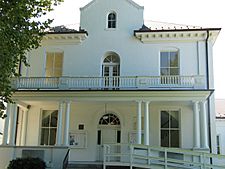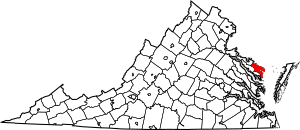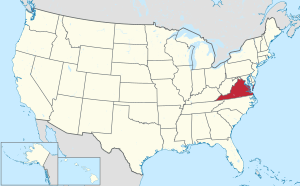Northumberland County, Virginia facts for kids
Quick facts for kids
Northumberland County
|
||
|---|---|---|

Northumberland County Courthouse in Heathsville
|
||
|
||

Location within the U.S. state of Virginia
|
||
 Virginia's location within the U.S. |
||
| Country | ||
| State | ||
| Founded | 1648 | |
| Seat | Heathsville | |
| Largest community | Heathsville | |
| Area | ||
| • Total | 286 sq mi (740 km2) | |
| • Land | 191 sq mi (490 km2) | |
| • Water | 94 sq mi (240 km2) 33.0% | |
| Population
(2020)
|
||
| • Total | 11,839 | |
| • Density | 41.40/sq mi (15.983/km2) | |
| Time zone | UTC−5 (Eastern) | |
| • Summer (DST) | UTC−4 (EDT) | |
| Congressional district | 1st | |
Northumberland County is a county located in the Commonwealth of Virginia. As of the 2020 census, the population sits at 11,839. Its county seat is Heathsville. The county is located on the Northern Neck and is part of the Northern Neck George Washington Birthplace AVA winemaking appellation.
Contents
History
The area was occupied at the time of English settlement by the Algonquian-speaking historic tribes of the Wicocomico and Chickacoan. The county was created by the Virginia General Assembly in 1648 during a period of rapid population growth and geographic expansion. Settlement began in this area of the Northern Neck around 1635. Originally known as the Indian district Chickacoan, the area was first referred to as Northumberland in the colonial records in 1644. The following year, John Mottrom served as the first burgess for the territory in the House of Burgesses, which met at the capital of the Virginia Colony at Jamestown.
The colonial court ordered the two tribes to merge and by 1655, assigned them a reservation of 4,400 acres (18 km2) near Dividing Creek, south of the Great Wicomico River. By the early 1700s, the Wicocomico tribe was greatly reduced, and English colonists took control of their lands. They were believed to be extinct as a tribe as, landless, they disappeared from the historical record. Descendants of the last weroance are working to regain recognition as a tribe, the Wicocomico Indian Nation.
The size of the county was drastically reduced in 1651 and 1653 when the colonial government organized Lancaster and Westmoreland counties from it.
Of the 172 counties that have ever existed in Virginia's history, Northumberland ended up being an "ancestor" to 116 of these –– more than the current 95 counties (several were lost to other states, such as West Virginia).
Geography
According to the U.S. Census Bureau, the county has a total area of 286 square miles (740 km2), of which 191 square miles (490 km2) is land and 94 square miles (240 km2) (33.0%) is water. The county is located between the Rappahannock River and Potomac River.
Adjacent counties
- Lancaster County - south
- Richmond County - west
- Westmoreland County - northwest
Demographics
| Historical population | |||
|---|---|---|---|
| Census | Pop. | %± | |
| 1790 | 9,163 | — | |
| 1800 | 7,803 | −14.8% | |
| 1810 | 8,308 | 6.5% | |
| 1820 | 8,016 | −3.5% | |
| 1830 | 7,953 | −0.8% | |
| 1840 | 7,924 | −0.4% | |
| 1850 | 7,346 | −7.3% | |
| 1860 | 7,531 | 2.5% | |
| 1870 | 6,863 | −8.9% | |
| 1880 | 7,929 | 15.5% | |
| 1890 | 7,885 | −0.6% | |
| 1900 | 9,486 | 20.3% | |
| 1910 | 10,777 | 13.6% | |
| 1920 | 11,518 | 6.9% | |
| 1930 | 11,081 | −3.8% | |
| 1940 | 10,463 | −5.6% | |
| 1950 | 10,012 | −4.3% | |
| 1960 | 10,185 | 1.7% | |
| 1970 | 9,239 | −9.3% | |
| 1980 | 9,828 | 6.4% | |
| 1990 | 10,524 | 7.1% | |
| 2000 | 12,259 | 16.5% | |
| 2010 | 12,330 | 0.6% | |
| 2020 | 11,839 | −4.0% | |
| U.S. Decennial Census 1790-1960 1900-1990 1990-2000 2010 2020 |
|||
2020 census
| Race / Ethnicity | Pop 2010 | Pop 2020 | % 2010 | % 2020 |
|---|---|---|---|---|
| White alone (NH) | 8,638 | 8,310 | 70.06% | 70.19% |
| Black or African American alone (NH) | 3,106 | 2,673 | 25.19% | 22.58% |
| Native American or Alaska Native alone (NH) | 20 | 14 | 0.16% | 0.12% |
| Asian alone (NH) | 36 | 67 | 0.29% | 0.57% |
| Pacific Islander alone (NH) | 2 | 0 | 0.02% | 0.00% |
| Some Other Race alone (NH) | 7 | 59 | 0.06% | 0.50% |
| Mixed Race/Multi-Racial (NH) | 139 | 365 | 1.13% | 3.08% |
| Hispanic or Latino (any race) | 382 | 351 | 3.10% | 2.96% |
| Total | 12,330 | 11,839 | 100.00% | 100.00% |
Note: the US Census treats Hispanic/Latino as an ethnic category. This table excludes Latinos from the racial categories and assigns them to a separate category. Hispanics/Latinos can be of any race.
Reedville, menhaden fishing industry
Reedville is a small village in eastern Northumberland County on the western shore of the Chesapeake Bay. Reedville is home to the Atlantic menhaden fishing industry. It is named for Captain Elijah W. Reed (1827-1888), who is credited with bringing the menhaden fishing industry, and the tremendous wealth that resulted from it, to Reedville –– and to Northumberland County in general.
Dozens of fish-processing factories, most recently Omega Protein Corporation (successor to Zapata Haynie, Reedville Oil and Guano Company and Haynie Products Company) and Standard Products Company, have dotted the Northumberland coastline near Reedville and adjacent fishing communities.
Today, Omega Protein remains the largest industrial organization in the area. Omega, with a fleet of large oceangoing fish-harvesting vessels, supported by a number of spotter aircraft, is a major industry in the area and on the Eastern seaboard. Menhaden, once caught, are cooked in large mass and processed for further use in various applications, including as a protein additive for poultry feed.
Located at the eastern terminus of U.S. Route 360, Reedville is a popular place to begin fishing charters and trips to Tangier Island in the Bay. Reedville is also a tourist destination itself, steeped in the history of the menhaden fishing industry. The Millionaire's Row of Victorian Era mansions and several watercraft of the Fishermen's Museum are listed on the National Register of Historic Places.
Communities
Town
- Kilmarnock in Lancaster County extends into southeastern Northumberland County.
Census-designated place
Other unincorporated communities
- Avalon
- Beverlyville
- Browns Store
- Bryant Corner
- Burgess
- Callao
- Coan
- Cowart
- Fairport
- Fleeton
- Lake
- Lottsburg
- Reedville
- Wicomico Church
See also
 In Spanish: Condado de Northumberland (Virginia) para niños
In Spanish: Condado de Northumberland (Virginia) para niños


